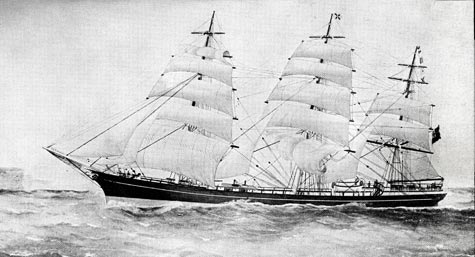
Windjammer British Isles
On Wednesday I raised the question – is history just a sea story? I found in researching my novel, Hell Around the Horn, that two memoirs written about the voyage of the British windjammer, British Isles, on which the novel is based, do not agree with each other or the Official Ship’s log. There was, however, one event on which all three primary sources agreed. The British Isles was struck and nearly sunk by an unusually large and massive wave. Ironically, this part of the story was not believed, even by experienced sailors of the time. See our previous post, Rogue Wave, 1905, and the Squarerigger British Isles
Alan Villiers who was an experienced Cape Horn sailor, didn’t believe that a single wave could do so much damage, dismissing it out of hand. In his book, War with Cape Horn, he comments on the damage to the ship: It is strange that the ship was so much damaged from her brush with the Horn. She was in the area for ten weeks, which is at least seven longer than was enough, but she was strongly built to take that sort of punishment indefinitely.
Until recently, such large waves were thought simply not to exist. Their reports had to be exaggerations or even excuses. When a ship was damaged in heavy weather by a freak wave, many thought that the captain was trying to cover for his inattention or attempt to carry sail for too long. The reports of huge waves were treated liked fish stories where the size of a fish caught on a fishing trip increased with the telling.
For centuries, every so often a ship would make to port and the captain would report encountering a monstrous wave that looked nothing like the other waves on the the sea. Significantly taller and steeper, it also traveled at an angle to direction of the wind. The stories were usually ignored.
As the science of oceanography advanced mathematical wave models were developed that were reasonably accurate in predicting sea states, including wave heights. The mathematical models agreed with the skeptics. No such massive waves could exist. They were sea stories, nothing more. Nevertheless the reports of huge waves continued.
Then on New Year’s Day, 1995, a huge wave hit the Draupner oil platform in the North Sea. What was different this time was that a downward pointing laser measuring device accurately recorded the wave. The wave looked just like the “mythical” waves described by ship’s captains. It was three times larger and far steeper than any nearby waves. It became known as the Draupner wave and those like it were called simply, rogue waves. Once satellite radar was developed that could measure wave height, rogues waves were found to be rare but not uncommon. In 2004, scientists using three weeks of radar images from European Space Agency satellites found ten rogue waves, each 25 metres (82 ft) or higher.
Ironically, after so many centuries in which rogue waves were dismissed as mere myths, the pendulum has swung the other way. Now it is not uncommon for news reports to call all large waves that strike ships as “rogue waves.” Fortunately, rogue waves are not as common as the current media might lead one to believe.
Writers aboard the Blog Hop – do please pay them all a visit!
- J.M Aucoin
- Helen Hollick
- Doug Boren
- Linda Collison
- Margaret Muir
- Julian Stockwin
- Anna Belfrage
- Andy Millen
- V.E. Ulett
- T.S. Rhodes
- Mark Patton
- Alaric Bond
- Ginger Myrick
- Judith Starkston
- Seymour Hamilton
- Rick Spilman
- James L Nelson
- S.J. Turney
- Prue Batten
- Antoine Vanner
- Joan Druett
- Edward James
- Nighthawk News

One account of the Sydney to to Hobart race the year many boats and lives were lost attributed the losses to rogue waves. Some boats just didn’t encounter them; they had a rough ride but no extreme danger. Other boats weren’t so lucky.
I don’t think those mathematical models said that rogue waves couldn’t occur; the probability distributions of wave heights had extreme waves off in the very low tail of the distribution.
Louis, you are right that the mathematical wave model did not actually say the wave could not occur. They showed them as such low probability events that, from a practical matter, it worked out to be almost the same thing. Even though rouge waves had been referred to as “100 year waves” I read of one estimate using the standard model that showed a rogue wave once every 10,000 years.
What a fantastic Voyage this Blog Hop has been! The third part of my Blog Hop article is now up – please do share in this final phase of the Nautical On Line Voyage http://ofhistoryandkings.blogspot.co.uk/2013/08/weigh-anchor-nautical-blog-hop.html
And…
Thank you to all who participated, authors and visitors alike. The Voyage has been wonderful!
I’m glad I finally got around to your post. I have always been fascinated by rogue waves, so this was very interesting to me. Thank you for participating in the hop!